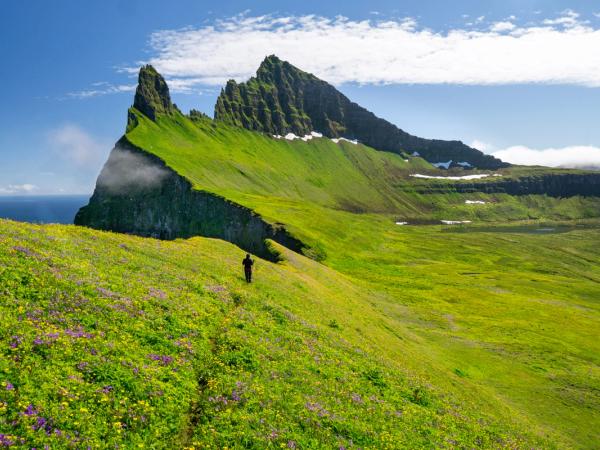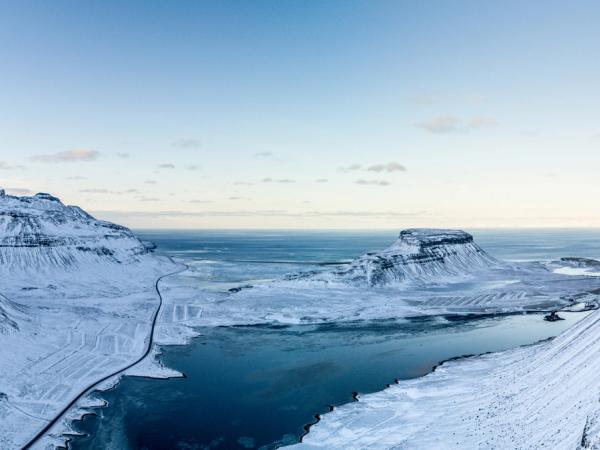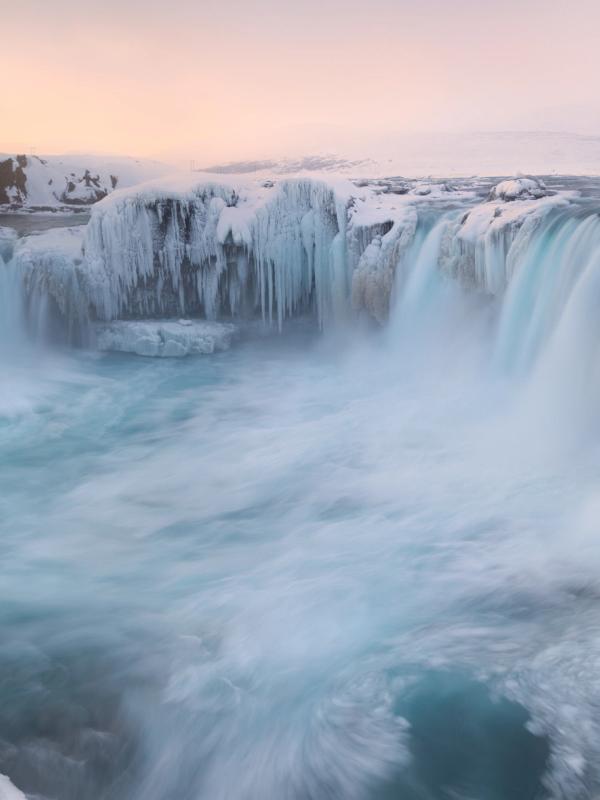
The Weather in Iceland: Temperatures, Regional Patterns & More
Iceland's weather is like the country itself – wild, beautiful, and always changing. From snowy winters to summer nights when the sun doesn't set, Iceland has a special climate that affects every trip. Knowing Iceland's weather will help you plan better.
Key Takeaways
- Iceland is warmer than you'd think, thanks to warm ocean currents
- Temperatures usually range from 14°F (-10°C) in winter to 57°F (14°C) in summer
- The south is warmer and wetter, while the north is colder with more snow
- Strong winds blow all year, mainly in winter
- Summer (June-August) has almost 24-hour daylight, while winter days have only 4-5 hours of light
- Weather changes fast – Icelanders say "if you don't like the weather, wait five minutes"
- 2025 has been unusually warm in February, March, and April
What's the Weather Like in Iceland? A Short Overview
Iceland sits near the Arctic Circle but gets warmed by ocean currents, making it milder than you might think. Still, this island lives up to its name with cold winters, mostly in the north and in the middle of the country.
The weather in Iceland changes fast. You might see sunshine, rain, snow, and wind all in one day – locals joke that Iceland has "all four seasons in a day." This fast-changing weather is part of what makes Iceland so special.
Recent trends show 2025 started with a cold January, followed by unusually warm February, March, and April. Last year (2024) was cooler and wetter than usual, with a very cold August and September.

Temperature in Iceland (All Year Round)
Iceland's temperatures aren't as cold as you might expect. Summer days are usually between 46°F and 57°F (8-14°C). Sometimes it gets above 68°F (20°C), but not often.
Winter in Reykjavík stays around freezing (32°F/0°C), sometimes dropping to 14°F (-10°C) during cold spells. Northern areas and the middle of the country get much colder, sometimes reaching -4°F (-20°C) in places like Akureyri, and even colder in the Central Highlands.
Spring (April-May) and fall (September-October) have temperatures between winter cold and summer warmth. Spring usually ranges from 32°F(0°C) to 48°F (9°C), getting warmer as summer gets closer. Fall temperatures are generally from 36°F(2°C) to 50°F(10°C), getting colder as winter comes. These times have fewer tourists, but the weather changes more from day to day.
Recent weather shows unusual warmth, with February reaching 37.6°F (3.1°C) in Reykjavík, 4.7°F (2.6°C) warmer than usual normal. April 2025 was the 5th warmest on record, reaching nearly 66°F (19°C) in some areas.
The south (including Reykjavík) stays milder thanks to the ocean, while inland and northern areas get much colder.

Rain in Iceland (All Year Round)
If there's one thing to prepare for in Iceland, it's rain. The country gets wet weather all year, with more rain in fall and winter.
Reykjavík gets between 2.2 and 4.5 inches (5.58cm and 11.4cm) of rain each month, with October usually being the wettest. The south and west coasts get more rain than other areas because they're first to meet storms coming from the Atlantic Ocean.
The north, including Akureyri, is drier, getting between 0.8 and 3.7 inches (2cm and 9.4cm) monthly. This means you might drive out of a rainstorm in the south into sunshine in the north.
Early 2025 has been wetter than usual, mostly February, which saw 5.6 inches (14.2cm) in Reykjavík (55% above average). April was drier across most of the country.
For travelers, this means waterproof clothing is a must, no matter when you visit. Rain in Iceland often comes sideways due to the wind, so umbrellas rarely work well.
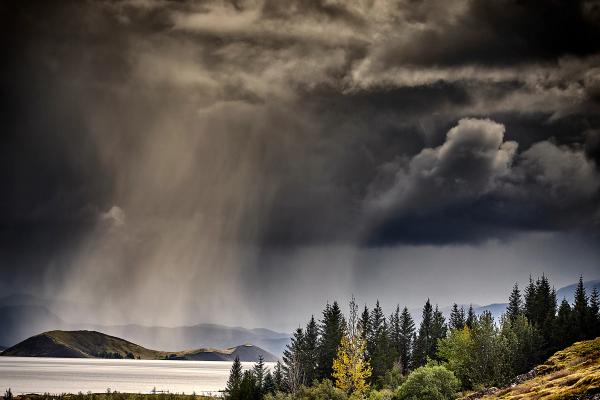
Snow in Iceland (All Year Round)
Snow is a big part of Iceland's winter, mainly from November through March. The amount varies a lot depending on where you are.
Northern Iceland, mainly around Akureyri, gets heavy snowfall, with January averaging about 20 inches (50.8cm). January 2025 saw very heavy snow in eastern Iceland, with record depths of 35 (89cm) inches at Dalatangi, the highest since 1966.
Reykjavík gets lighter snow, usually peaking at around 10 inches (25.4cm) in January. Snow in the capital often doesn't stay long, with frequent melting and freezing again.
The middle of the country remains covered in snow much longer, with some mountain areas keeping snow all year. Roads often close in winter, with highland roads completely shut from around October to May.
Interestingly, February and March 2025 had very little snow. Reykjavík had only 3 snow-covered days in February (9 below average), while Akureyri had just 4 (12 below average), the least since 2006.

Wind in Iceland (All Year Round)
Perhaps the most challenging part of Iceland's weather is the wind. The country has strong winds all year, but winter brings especially strong gusts that can make even mild temperatures feel freezing.
Average wind speeds in Reykjavík range from 8 mph in summer to about 16 mph in winter. The southwest tends to be windier than other areas.
Wind in Iceland can change quickly, sometimes reaching dangerous speeds during storms. February 2025 saw bad storms that caused widespread damage and travel problems across the south and west coasts.
For travelers, the wind means dressing in layers and always having a windproof jacket. Small items can blow away, car doors can get damaged when opened in strong gusts, and hiking can become dangerous during windy conditions.
Interestingly, January and March 2025 were unusually calm, with wind speeds much lower than average.

Daylight Hours in Iceland
Iceland's location creates big changes in daylight hours – something most visitors notice right away.
Summer brings the famous "Midnight Sun", with nearly 24 hours of daylight in June and July. The sun briefly dips below the horizon, but it doesn't get dark enough to see stars. This endless light gives you plenty of time for activities, but can make sleeping hard.
Winter is the opposite. December and January have just 4-5 hours of daylight, with the sun rising around 11:00 AM and setting by 3:30 PM. The winter sun stays low in the sky and creates a golden light that photographers love. Plus, it creates the perfect conditions to see the Northern Lights.
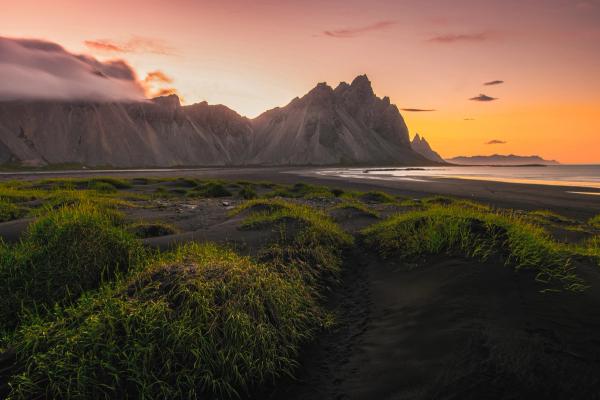
Weather & Temperatures in Iceland By Month
Iceland’s weather (like in most places) changes a lot from month to month, mainly from season to season, so knowing what to expect is essential to plan your trip.
January
January is cold and dark, with temperatures from 28°F (-2ºC) to 37°F (3ºC) in Reykjavík and colder up north. Heavy snow in the north, lighter in Reykjavík. The windiest month, with just 4-5 hours of daylight. Perfect for Northern Lights.
February
February is cold but slightly warmer than January. February 2025 was unusually warm at 37.6°F (3ºC) in Reykjavík, much above average. Daylight increases to 7-10 hours. Still snowy, mainly in the north, with possible storms.
March
March is a changing month with temperatures from 28°F (-2ºC) to 39°F (4ºC). March 2025 continued the warm trend at 37.6°F (3ºC) in Reykjavík. Daylight extends to about 12 hours. Snow starts melting in the lower areas.
April
Spring arrives in April, with temperatures from 32°F (0ºC) to 43°F (6ºC). April 2025 was very warm, the 5th warmest on record. Daylight stretches to 13-16 hours. The Northern Lights are still visible until mid-month.
May
May comes with mild days and temperatures from 37°F (3ºC) to 48°F (9ºC). May is usually Iceland's driest month. Daylight extends to 17-20 hours with bright nights. Spring flowers appear, and puffins return to the coast to begin their mating process.
June
June marks the start of summer, with temperatures from 45°F (7ºC) to 52°F (11ºC). There is nearly 24-hour daylight with the Midnight Sun. Snow is very rare, except in the Highlands. It was a relatively dry month and great for exploring.
July
July is Iceland’s warmest month, with temperatures from 46°F (8ºC) to 55°F (13ºC), rarely going above 68°F (20ºC). You can still enjoy nearly 24 hours of daylight. It’s one of the driest months and the busy season for tourism. All Highland roads are usually open.
August
August is still mild, with temperatures similar to July. August 2024 was unusually cold, with some of the lowest temperatures in August this century. Daylight decreases to 16-18 hours. Slightly wetter than July.
September
Cooling begins in September, with temperatures ranging from 41°F (5ºC) to 50°F (10ºC). September 2024 was unusually cold, the coldest since 2005. Daylight drops to 11-14 hours. The Northern Lights become visible again late in the month.
October
October is colder, with temperatures from 36°F (2ºC) to 45°F (7ºC). October is often the wettest month. Daylight shortens to 8-11 hours, perfect for Northern Lights viewing. Snow returns to the Highlands and sometimes the north.
November
Winter approaches in November, with temperatures from 32°F (0ºC) to 39°F (4ºC). November 2024 was a mix– warm first half, cold second half. Daylight reduces to 5-8 hours. Snow increases, mainly in the north.
December
December is cold and dark, with temperatures that go from 28°F (-2ºC) to 36°F (2ºC). Heavy snow in the north, lighter in Reykjavík. Very strong winds with frequent storms. Just 4-5 hours of daylight. Prime Northern Lights season.
Weather in Iceland by Region
Iceland is not a vast country, but the weather varies a lot from region to region. Besides the month you choose to visit the country, choosing the correct regions to see is also super important. Here’s what you should know,
South Iceland (Reykjavík, Vík)
The south, including the capital Reykjavík, is milder than the rest of Iceland thanks to warm ocean currents. Winters hover around freezing, while summer highs reach about 57°F (14ºC). This region gets more rainfall than the north, with frequent rain in winter and lighter rain in summer. Snow falls in winter but often doesn't last long in Reykjavík. The south coast can be very windy, with strong gusts from the ocean.
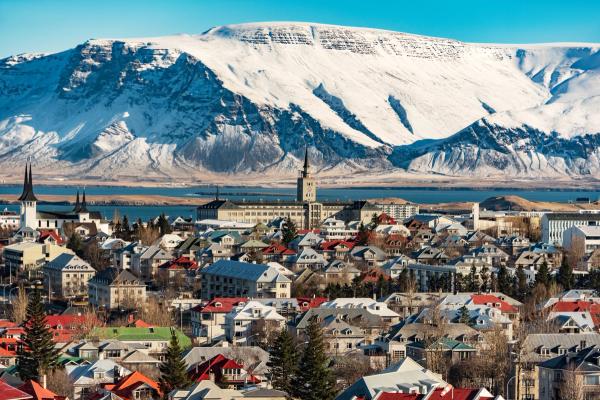
North Iceland (Akureyri)
The north has colder temperatures, mainly in winter when it frequently drops below freezing. Winter temperatures in Akureyri average around 32°F (0ºC), with average lows of 19°F (-7ºC) in December and January. Summers reach about 56°F in July. This region gets less rain than the south but more snow, with January averaging 20.4 inches of snowfall. The north often has clearer, calmer days than the stormy south.
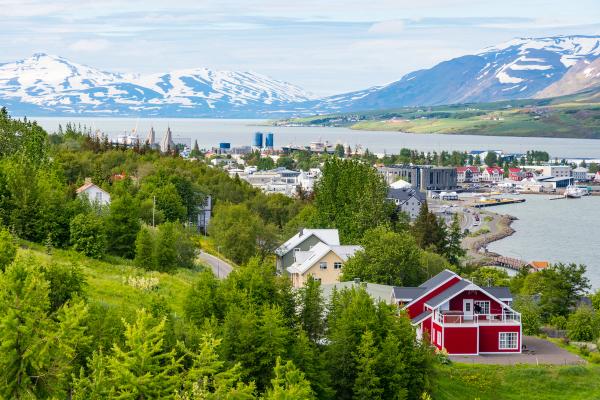
East Iceland
East Iceland can truly have "all four seasons in a day" with quickly changing weather. This region once recorded Iceland's highest-ever temperature of 86.9°F (30ºC) in 1939. East Iceland tends to be colder and more changing than the south. Heavy snow can hit the eastern fjords, as seen in January 2025, when record snow depths of 35 inches were recorded at Dalatangi, forcing people to leave their homes due to avalanche risks.
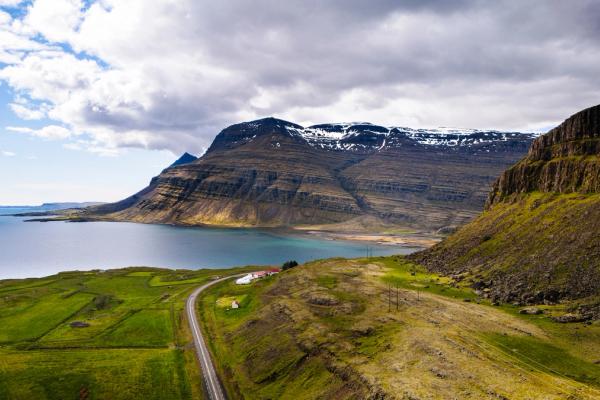
West Iceland (Snæfellsnes, Westfjords)
The west, mainly the Westfjords, gets heavy winds, rain, and snow, mainly in winter. This region sees warm and cold air masses meeting, leading to changing conditions. The Westfjords can be closed in winter due to heavy snowfall, but serve as a key economic and transportation hub during the milder seasons. Wind and snow can happen year-round in the Highlands of western Iceland.

Highlands (Central Iceland)
The highlands have the harshest conditions in Iceland. Winter brings frequent blizzards, heavy snow, and temperatures well below freezing. Even in summer, the Highlands can get sudden snowfall and freezing temperatures. Most highland roads (F-roads) stay closed from October to late May or even June. This region has the most extreme conditions but also some of Iceland's most dramatic landscapes.

Tips to Tackle the Icelandic Weather
Knowing what to expect from Iceland’s weather is the first step towards a comfortable trip, but knowing how to act against the bad weather (and how to maximize the good one) is also key.
- Layer your clothing: The best way to handle Iceland's changing weather is to wear multiple thin layers rather than one thick layer. This keeps you warm and lets you adjust as conditions change (which will do).
- Always pack waterproof gear: No matter when you visit, bring a good waterproof and windproof jacket and pants. Waterproof hiking boots are key year-round.
- Check road conditions daily: If driving, check road.is every morning. Conditions can change overnight, with roads that were open suddenly being closed.
- Download the 112 Iceland app: This safety app lets you check in and send your location to emergency services if needed.
- Be flexible with your plans: Build extra time into your schedule and have backup plans for activities in case the weather disrupts your original plans.
- Consider regional differences: If the forecast looks bad in the south, the north might have clear skies. Be ready to change your itinerary if needed.
- Use weather apps wisely: The Icelandic Meteorological Office app (Veður) gives the most accurate forecasts for Iceland.
- Be extra careful in winter: Shorter daylight hours mean less time for activities and driving. Plan accordingly and don't try to do too much.
- Bring eye protection: Sunglasses help with both bright summer days and winter snow glare. Wind can also blow sand and dust.
- Respect weather warnings: Icelanders take weather warnings seriously – you should too. Don't go out in bad conditions.
- Dress for swimming: Despite the cold, bring swimwear. Hot springs and swimming pools are perfect in any weather.
- Pack for indoor comfort: Icelandic buildings are well-heated, so bring lighter clothes for indoor, even in winter.
Conclusion
Iceland's weather is as wild and changing as its landscapes. From the dark, stormy winters to the endless light of summer, each season offers a different view of this fantastic island.
Remember that Iceland's weather is part of what makes this country so special. The forces that create harsh conditions are the same ones that shaped its stunning waterfalls, carved its glaciers, and power its hot springs. Embrace the weather as part of your Icelandic adventure, and you'll go home with stories of not just dealing with the weather but experiencing it as a key part of this fantastic place.

